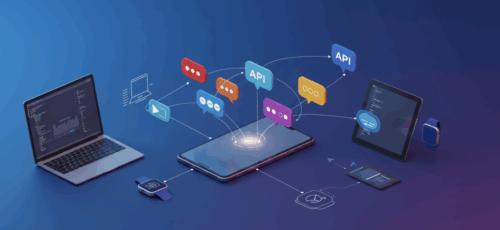Understanding the Importance of Voice APIs in Modern Communication
The way businesses handle voice communication is evolving. Instead of relying on rigid, traditional phone systems, companies are embedding real-time voice control capabilities directly into their software and platforms. Whether it’s enabling voice-based customer support, automating call routing, or integrating voice features into existing applications, programmable voice solutions provide the flexibility developers need to build smarter communication tools.
For developers, the advantage lies in control and customization. With a robust API, voice functionalities can be tailored to fit specific business needs—whether that’s embedding calling features into a CRM, managing high-volume call flows, or ensuring uptime with carrier-resilient networks. Instead of dealing with outdated telecom infrastructure, modern voice solutions offer scalability, reliability, and the ability to pay only for what’s used.
What is a Voice API?
A voice API (application programming interface) is a tool that allows internet-based applications to make and receive phone calls. It connects applications to the Public Switched Telephone Network (PSTN) efficiently and seamlessly.
APIs allow software developers to integrate voice calling into software, systems, and apps. It to PSTN and VoIP networks, enabling seamless voice communication without the need for telecom expertise. Developers can focus on creating engaging customer experiences rather than building solutions from scratch.
How Do APIs Work?
APIs act as a bridge between internet-based applications and traditional phone networks. Here’s a simple breakdown of how it works:
- Internet-Based Applications: Developers integrate the voice API into their app or service.
- PSTN and VoIP: The API connects the app to the PSTN and VoIP networks.
- Call Logic: The API handles all telephony functions, such as making, receiving, and managing calls. This includes routing calls to phones, browsers, SIP domains, and mobile applications.
This setup method also allows applications to programmatically manage calls, providing a seamless experience for users.
Benefits of Embedding Real-Time Voice Capabilities
Voice APIs offer several key benefits that make them an attractive option for businesses and developers:
- Configurability: APIs are highly configurable, allowing businesses to tailor their communication solutions to meet specific needs. Flexibility enables businesses to build upon the API progressively rather than being locked into a single solution.
- Scalability: Cloud-based voice APIs offer exceptional scalability. They can dynamically adjust to handle high call volumes without requiring additional on-site infrastructure. This elasticity ensures that businesses can scale their communication capabilities as needed.
- Cost-Effectiveness: Using APIs reduces the need for expensive telecom infrastructure and specialized developers. It also lowers operational costs by leveraging cloud-based solutions, making it a cost-effective choice for businesses of all sizes.
- Customer Experience: APIs enhance customer experience by enabling features like click-to-call, automated IVRs, and intelligent call routing. Companies can achieve faster issue resolution and more personalized interactions.
Voice APIs simplify the integration of voice calling and functionality into applications, making it easier for developers to create rich, scalable, and cost-effective solutions. By leveraging these tools, businesses can improve customer experiences and drive efficiency.
Key Features of Programmable Voice Technology
APIs come packed with powerful voice features that make them essential for modern communication solutions. Let’s dive into some of the key functionalities that make a voice API a must-have for developers and IT leaders.
Seamless Global Audio Conferencing
Connecting teams worldwide demands high-quality, low-latency voice communication that works across borders. With programmable voice solutions, developers can integrate global web conferencing capabilities that deliver crystal-clear audio no matter where participants are located.
- Customizable Call Behavior: Define participant roles dynamically, controlling who can speak, listen, or moderate discussions in real time.
- Worldwide Connectivity: Enable seamless communication between users across different regions without worrying about network incompatibilities.
- Real-Time Participant Management: Mute, unmute, place calls on hold, or remove participants instantly to maintain a smooth conferencing experience.
With these capabilities, businesses can create scalable, high-fidelity conferencing solutions that support global collaboration without the need for expensive infrastructure.
Real-Time Media Streaming for Advanced Call Insights
Media streaming—also known as media forking—opens up new possibilities for analyzing and optimizing phone calls without disrupting call quality. By duplicating audio streams and sending them to multiple endpoints, businesses can unlock valuable insights in real time.
- Live Call Analysis: Perform sentiment detection, identify potential fraud, and authenticate users through voice biometrics.
- Optimized Call Quality: Maintain superior audio performance, ensuring every duplicated stream remains clear and uninterrupted.
This functionality empowers developers to build AI-driven solutions that enhance security, compliance, and customer engagement through real-time device monitoring.
Text-to-Speech for Personalized Interactions
Converting text into lifelike speech enhances accessibility and creates more dynamic user experiences. Whether it’s for customer notifications, interactive voice response (IVR) menus, or automated assistants, TTS solutions deliver seamless communication.
- Dynamic Content Generation: Generate real-time spoken messages based on user inputs, system updates, or contextual triggers.
- Multilingual Support: Expand your audience reach with natural-sounding voices in multiple languages and accents.
By integrating advanced TTS capabilities, businesses can craft personalized, scalable, and globally accessible voice interactions.
AI-Powered Smart IVR Systems
Traditional IVR systems can frustrate customers, but AI-driven solutions transform automated menus into intuitive, responsive experiences. With a customized voice platform, businesses can create intelligent, multi-level IVR systems that improve voice calls and customer interactions.
- Smart Call Routing: Direct customers to the right department or agent based on intent, reducing wait times and improving satisfaction.
- Omnichannel Integration: Connect voice calls with chat, email, and SMS to create a unified customer experience.
- AI-Driven Automation: Use natural language processing (NLP) and machine learning to handle routine inquiries, freeing up human agents for complex cases.
By implementing intelligent IVR technology, companies can reduce operational costs while delivering faster, more effective customer support.
Answering Machine Detection for Smarter Outbound Calls
Maximizing the effectiveness of outbound phone calling campaigns requires knowing whether a call is answered by a person or a machine. Answering Machine Detection (AMD) ensures every call is handled appropriately.
- Automated Message Optimization: Use speech recognition to detect whether a call reaches voicemail or a live person and tailor responses accordingly.
- Instant Webhook Notifications: Trigger immediate updates to adjust call flows and improve engagement rates.
With AMD, developers can refine outbound strategies, improve connection rates, and enhance customer interactions. By leveraging these advanced capabilities, businesses can build robust, scalable voice applications that enhance customer experience and operational efficiency. Programmable APIs form the backbone of seamless, intelligent voice interactions in modern applications.
Common Use Cases for Programmable Voice APIs
Voice APIs are versatile tools that developers can use to enhance various applications. Here are some common use cases:
Contact Centers
Voice APIs are a game-changer for contact centers. They enable:
- Interactive Voice Response systems to route calls efficiently.
- Call recording for quality assurance and training.
- Real-time transcription and speech recognition to capture customer interactions accurately.
For example, a financial institution improved customer service by using a voice API to handle a high volume of calls, significantly reducing wait times.
UCaaS Platforms
Unified Communications as a Service (UCaaS) platforms benefit greatly from APIs. They support:
- Global audio conferencing with configurable behavior and participant control.
- Media streaming for real-time analysis and improved call quality.
- Text-to-Speech for accessibility and dynamic text conversion.
By integrating these features, UCaaS platforms can offer a seamless communication experience across multiple calls in various regions.
Cloud-Based IVRs
Cloud-based IVRs leverage APIs to:
- Automate call routing based on customer input.
- Provide self-service options to reduce the load on human agents.
- Integrate with CRM systems to offer personalized service.
A retail company used a voice API to implement a cloud-based IVR, which decreased customer wait times and improved satisfaction.
Call Tracking
Marketers can use APIs for call tracking to measure the effectiveness of their campaigns. This involves:
- Assigning unique numbers to different marketing channels.
- Tracking call data to analyze campaign performance.
- Generating reports to optimize marketing strategies.
For instance, a company tracked its billboard ads using different phone numbers and a voice API, helping them identify the most effective locations.
AI Applications
APIs can be integrated with AI technologies to create smart applications, such as:
- Voice bots that handle customer queries.
- Speech analytics to gauge customer sentiment.
- Predictive dialing for outbound sales calls.
An insurance company used AI-driven APIs to automate claim processing, reducing manual work and speeding up service delivery.
Voice Notifications
Programmable voice APIs are ideal for sending automated voice call notifications. Use cases include:
- Appointment reminders for healthcare providers.
- Delivery updates for logistics companies.
- Emergency alerts for public safety.
A healthcare provider used voice APIs to send appointment reminders, reducing no-show rates and improving operational efficiency.
These use cases demonstrate the flexibility and power of voice APIs in various applications, making them essential tools for modern communication solutions.
How Much Does a Voice API Cost?
Choosing the right API platform means understanding not just the features but also the pricing structure. Costs can vary depending on factors like call types, usage volume, and additional functionalities. Knowing what influences pricing helps businesses make informed decisions while keeping expenses in check.
Call Types and Pricing
Different call types come with varying costs. Here’s a general breakdown:
- Local Calls: Typically the most cost-effective option, ideal for businesses handling high volumes of domestic communication.
- Toll-Free Calls: These often come at a premium, as businesses cover the cost to provide a free high-quality voice calling experience for customers.
- SIP, Browser, or App Calls: Usually the most affordable, leveraging internet-based calling for seamless communication at minimal expense.
Understanding which call type aligns with your business needs ensures you get the best value without unnecessary spending.
Volume-Based Pricing and Discounts
For businesses handling high call traffic, volume-based pricing can offer significant savings. Many providers reduce per-minute rates as usage per phone line increases, making it more cost-effective for companies that rely heavily on voice communications.
Choosing a pricing model that scales with your needs allows for better cost management while ensuring reliable service, even during peak call times.
Additional Costs to Consider
Beyond per-minute rates, there are other potential expenses to factor in:
- Business Phone Numbers: The cost of acquiring and maintaining local, toll-free, or vanity numbers may vary.
- Advanced Features: Add-ons like call recording, real-time transcription, or AI-powered IVR systems may come with extra fees.
Balancing cost with the right mix of features and reliability ensures your business gets the most out of its voice communication strategy. By evaluating pricing structures and potential add-ons, businesses can optimize their investment in a voice API while maintaining seamless connectivity.
Building a Smarter, More Resilient Communication System
Businesses need communication solutions that are flexible, reliable, and secure. The right technology should empower developers with seamless integration, robust security measures, and the scalability to grow alongside business needs. When evaluating options, consider factors like language compatibility, ease of implementation, and fraud prevention to ensure a future-proof system that enhances both user experience and operational efficiency.
By integrating a voice API, you can enhance your customer experiences, streamline operations, and ensure business continuity, all while enjoying top-notch developer support and scalability. Get started in minutes with Flowroute today.

Mitch leads the Sales team at BCM One, overseeing revenue growth through cloud voice services across brands like SIPTRUNK, SIP.US, and Flowroute. With a focus on partner enablement and customer success, he helps businesses identify the right communication solutions within BCM One’s extensive portfolio. Mitch brings years of experience in channel sales and cloud-based telecom to every conversation.






